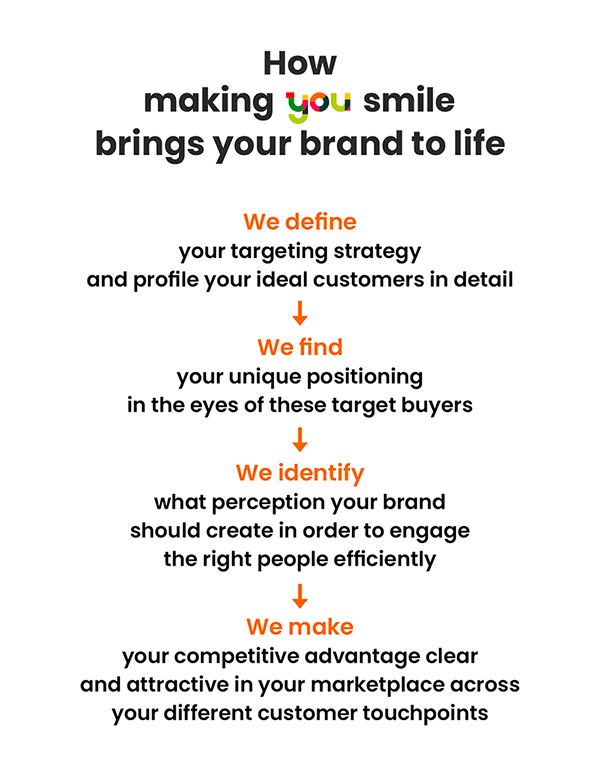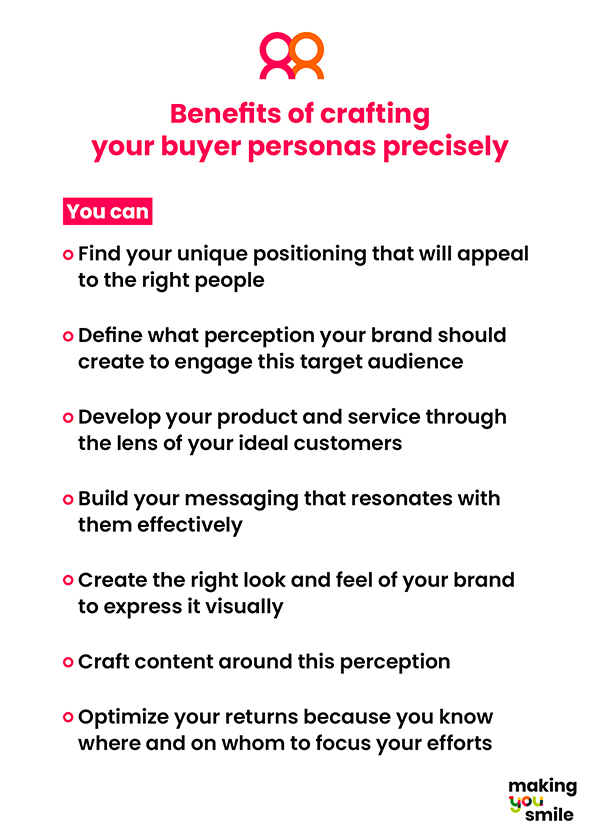Selling the impossible
Here's how a sales legend changed the game.
- Taehee Kim Verney-Carron
“We’ve spent a lot of money on marketing. We’ve done all kinds of paid campaigns, been at industry events to showcase our offer, and even nailed our pitch to grab people’s attention. But it’s still so hard to finalize the deal. Plus, I hate selling!”
How familiar does this sound to you? Right. Let’s admit it. We’ve all been there.
At Making You Smile, one of our most important missions is to empower each of our client’s businesses to be able to put an end to pointless marketing and sales efforts.
How do we do this? By instead helping them to build a brand. We bring clarity to their brand strategy so that they’re able to focus their resources efficiently.
Here’s how it works.
We help our clients to do the following:
In short, we guide them through the journey of building a powerful strategy and implementing it with elegance. That’s how we bring their brand to life.
Hold on. Have you noticed which word we’ve repeated the most throughout the journey?
If you got the answer right, you’re already, with a little bit of exaggeration, half-way through the journey of building a solid brand.
Exactly. Understanding your “target” customers deeply is key to everything. It helps you identify where and how to reach these people with what message. You’ll also better know what brand experience you should consistently create to convince them to buy from you and turn them into your loyal customers.
In this blog post, we’re going to talk about how to profile your ideal customers and why it is extremely useful to build out a buyer persona as specifically as possible.

In our last article, we explained that your brand strategy is your business strategy turned into your target audience’s point of view.
A business strategy maps out the path a company should take to get to its destination. It details your firm’s organizational vision, mission, and long-term objectives. It elaborates especially how you can reach your desired financial results by successfully competing in your market.
A well-defined brand strategy enables a company to clearly express a reason, both rational and emotional, to their target customers for why they should buy from them instead of a competitor.
That being said, make sure you clearly define your answer to the following question: How do we solve our target buyers’ problems in a way that no one else does?
Articulating the right answer to this question is fundamental to the ultimate success of your business. And to achieve that, it’s crucial to identify who your ideal customers are and how they think and behave.
The definition of a buyer persona varies slightly from one source to another, but it converges into the common notion of a (semi) fictional representation of your ideal customer.
Shopify.com, the well-known multinational e-commerce platform originating from Canada, explains that a buyer persona is a fictionalized characterization of your best customer(s) based on information about them and how they use your product or service.
Although they are fictional, your buyer personas might strongly reflect the insights that you have learned from your existing customers. Also, these personas are based on deep research into your desired clients. That’s why a buyer persona is a detailed description of someone that mirrors your “ideal” customer.
Why is creating a buyer persona so important? It’s because whether you’re a B2C or B2B, you’re addressing another human being with experiences, requirements, and even biases. Buyer personas help you understand your target customers on a deeper emotional level and thus elaborate the right strategy to engage the right people.
Profiling your ideal customers in detail will help you focus your efforts and resources. It brings clarity and deeper insight when you determine what emotions your brand experience should evoke to stay aligned with its pursued positioning.
A detailed buyer persona will guide product or service development. Tailoring your content becomes simpler. Brand perception is more likely to be consistent across your different customer touchpoints and over time.
Then what information should it include?
a. Give them a name.
This will humanize your buyer persona.
b. Collect relevant data about WHO they are.
Fill in your persona's demographics.
Gender, age, where they live/work, profession, education, income, family situation (in a relationship/married/have or have no children, etc.)
c. Dig deeper into HOW they are.
Identify the psychographics – this is where you can make a real difference to build a unique strategy.
Lifestyle and personality
- Hobbies, interests, things they enjoy, places they like spending time in, brands they like, etc.
Attitude and purpose
- Mindset, values, beliefs, motivations, and goals
Customer experience they wish for
- Pain points and desired results or experience. Focus on their hidden wants beyond their needs
Once your buyer personas are elaborated, define with clearly worded statements what would make your brand unique to them. How do you solve their problems in a way that no one else does? Clarify what perception your brand should create to engage these specific people.
After you complete that, you can move on to the following:

An example. Recently, we’ve been working with a young company that is launching a B2B brand in a sector where customers are often left lost in opaque procedures and the tedious tasks required (-> pain point).
In general, the buyers in this field are rather skeptical about finding a competent, reliable, and attentive advisor that can simplify their life (-> desired experience and result).
Fortunately, their offering could truly solve those people’s problem. But what brand strategy is needed to clearly express a reason, both rational and emotional, to their target customers for why they should buy from them instead of a competitor?
There was no doubt that the brand should indispensably be built around the image of trust and dependability. A brand that would typically be categorized into the archetype of “sage” by brand analysts (-> needs).
However, by deeply diving into the psychographics of their ideal customers as well as the vision that the founders of this new company have for their brand, we had a surprise. Their buyer persona clearly indicated that this brand would also have to manifest the characteristics of an “explorer” (-> lifestyle, personality, motivation, and hidden wants).
And that is totally unusual for the sector they’re in, which is fantastic for them to stand out among the crowd.
How does this affect their branding? Enormously. Their messaging strategy and overall visual brand design concept strongly reflect it. And it’s being integrated into everything related to creating a brand experience, including their website, business cards, social media, and other marketing and sales tools.

Would they have been able to define their brand positioning as such without building out their buyer persona precisely?
We seriously doubt it.
Here’s the conclusion.
It is extremely beneficial to take the time to profile your ideal customers thoroughly. That’s because, without a clear and profound understanding of your target buyers, you are very likely to struggle to come up with the right strategy to convince them to buy from you.
Stop addressing the wrong people. Don’t waste your time and resources anymore. Say goodbye to pointless marketing and sales efforts.
Instead, bring clarity to your brand strategy so as to know where and on whom to focus your efforts and investments.
If you do it right, you will see your business take off in no time.
Here's how a sales legend changed the game.
- Taehee Kim Verney-Carron
When you confuse strategy with a plan, things can get very messy.
- Taehee Kim Verney-Carron
We see lots of, lots of companies prioritize design over messaging. It's a terrible mistake.
- Taehee Kim Verney-Carron
This is a personal essay. And It's time for a change.
- Taehee Kim Verney-Carron
We're all desperate to feel 'this way'—what does it mean for your brand?
- Taehee Kim Verney-Carron
Writing long but specific > Writing short and abstract
- Taehee Kim Verney-Carron
Learn how to nail targeting, messaging, and storytelling from Scarlett Johansson.
- Taehee Kim Verney-Carron
Stand out from the competition—everyone wants that. But how? That’s where Steve Jobs meets Socrates.
- Taehee Kim Verney-Carron
Have you ever noticed some brands build connections with people better than others? How about…
- Taehee Kim Verney-Carron
These totally actionable and specific ideas will give you the insight and power you need…
- Taehee Kim Verney-Carron
Here are the 5 simple steps to building an outstanding webpage that engages the right…
- Taehee Kim Verney-Carron
Are you wondering how to position your business clearly? Apply this framework.
- Taehee Kim Verney-Carron
“What unites people? Armies? Gold? Flag? Stories. There’s nothing in the world more…
- Taehee Kim Verney-Carron
Many people are puzzled about why their marketing actions are not bringing the results they…
- Taehee Kim Verney-Carron
It starts with getting your targeting strategies right.
- Taehee Kim Verney-Carron
At Making You Smile, we often get asked to clarify what a brand strategy is.…
- Taehee Kim Verney-Carron
Our experience as a branding agency makes us believe that many, many people have a…
- Taehee Kim Verney-Carron
Countless articles and posts identify how Don shows that what a company sells is more…
- Taehee Kim Verney-Carron
As a branding agency, we know just how misunderstood the relationship between branding and marketing…
- Taehee Kim Verney-Carron
Many people believe that branding = design & taglines. Wrong. A brand strategy is much…
- Taehee Kim Verney-Carron
At Making You Smile, quite a few of us have children aged between 5 and…
- Taehee Kim Verney-Carron